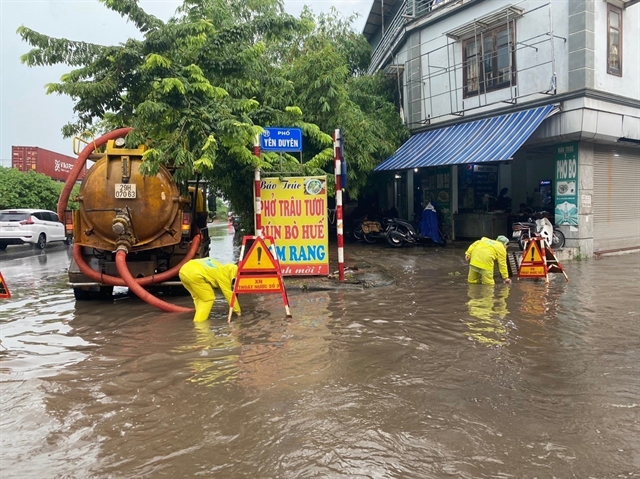 Environment
Environment

 |
| Parts of Yên Duyên Street in Hoàng Mai District, Hà Nội flooded after heavy downpours on Friday afternoon. — VNA/VNS Photo |
HÀ NỘI — As urban flooding becomes a common sight in major and populated cities across the country, experts emphasise comprehensive sets of measures to mitigate the issues.
Vice chairman of Vietnam Water Supply and Sewerage Association (VWSA) Trần Anh Tuấn said that the primary cause for the phenomenon is climate change.
Unusual downpours have been on the rise, while there is a lack of stringent management at the district level on the degrading drainage systems, he said.
Littering and improper disposal of construction materials also contribute to the problem, Tuấn added.
The VWSA vice chairman said urbanisation is happening at a rapid pace but drainage infrastructure, including detention basins, in these areas has not caught up.
In these new urban locations, with the exception of ponds and lakes, concrete is excessively used on most surfaces.
The ground surfaces in residences, office buildings and even paved sidewalks are now lined with a layer of concrete beneath, which prevents rainwater to drain into the ground below, said Tuấn.
Meanwhile, the design and sectionalisation for water drainage in areas with different altitudes are not conducted thoroughly, causing water to flow into low-lying areas and leading to prolonged inundation.
Dr Trần Đình Hòa, director of the Vietnam Academy for Water Resources (VAWR) said that urban flooding is no longer limited to coastal cities, and is now recorded in deltas and mountainous areas, such as Đà Lạt or Lai Châu.
Climate change has increased extreme and abnormal weather phenomena that exceed forecasting capacity, he said.
At the same time, the rising sea level and alluvium shortage also worsen inundation in coastal areas affected by tides.
The growing water flows into deltas, due to natural causes as well as incomprehensive and unsustainable resource management, have drastically altered stream morphology, said Hòa.
The lower riverbed and decreasing amount of alluvium and silt mean the water is flowing downstream at a much higher speed than before.
Heavy rain in urban areas and floods from the upstream, and sometimes tides, create an unfavourable combination that increases the chances of serious and complicated flooding.
Dr Hòa said that this situation is dangerous for low-lying areas such as HCM City, the coastal cities of Đà Nẵng and Hội An, as well as the Mekong Delta.
To reduce local flooding in cities, VWSA vice chairman Trần Anh Tuấn suggested having a master plan for the water drainage system based on sciences and urban development.
This system must align with the vision for the city’s growth, the allocation and development of residential areas, as well as roads and waterways, he said.
Meanwhile, investment resources must focus on drainage construction that should be maintained by each locality and its people.
Dr Trần Đình Hòa believed that in the near future, major cities need to take measures to address the drainage issues, while also strengthening coordination between State management, local authorities and the related sectors.
One of the examples is the cooperation between water resources agencies, which are specialised in hydrodynamics, waterlogging techniques and management, and construction agencies, which are specialised in the construction engineering and management of the urban drainage system.
Hòa added that localities need to enhance communication and raise awareness among people in ensuring an efficient drainage network, and strictly handle violations such as encroachment and littering that block the water flows. — VNS




